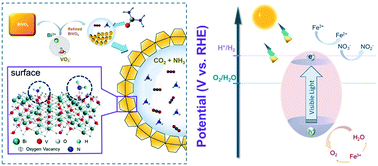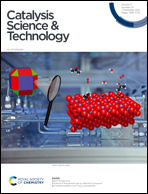The effect of Fe(iii) ions on oxygen-vacancy-rich BiVO4 on the photocatalytic oxygen evolution reaction†
Abstract
Achieving efficient separation and transfer of the photogenerated carriers is significant in improving photocatalytic water oxidation activity over BiVO4. This is strongly related to the particle structure and surface chemistry. Here, a BiVO4 photocatalyst is synthesized by a co-precipitation method, in which urea is used as a pH modifier and bubble template growth agent. The synthesized BiVO4 particles show abundant oxygen vacancies and a higher {110} to {010} facet ratio than the case without a urea agent. The optimized BiVO4 samples exhibit very high catalytic activity, with the oxygen evolution rates of 680 μmol h−1 and 176 μmol h−1 with the sacrificial agents AgNO3 and Fe(NO3)3, respectively, corresponding to the apparent quantum efficiency (AQE) of 77.8% and 19.6% under 420 nm light irradiation. Interestingly, both results exceeded the theoretical oxygen evolution values which calculated from the reduction number of metal cations (Fe3+ → Fe2+, Ag+ → Ag). Based on a series of comparative experiments, we speculated that a new reaction might occur on the surface of BiVO4 in the solution during the photocatalytic oxygen evolution. It is expected that the proposed strategy and reaction mechanism could be extended to other photocatalysts' designs and applications.



 Please wait while we load your content...
Please wait while we load your content...